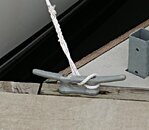KevinG58
Contributor
OMG! That one deserves being in the need to know list. Not so much the name but where they are and how to close them!
To expand a little, there are lots of pipes and tubes that penetrate the hull below the waterline. As Eric said, a seacock or valve is attached directly to each through-hull fitting. The other side of the valve is most often connected to where it is needed with a flexible hose engine cooling water (supply and returns), sewage discharge, bilge pumps, etc.
Hoses eventually fail, which causes the boat to take on water as in sinking! Several people onboard need to know where the sea cocks are and how to close them when the bilge alarm starts going off. Oh yeah, you also need to learn what a bilge alarm(s) sounds like so you dont assume the reefer (refrigerator) door has been open too long.
Also on the need to know list is how to deal with a fire. Find the fire extinguishers and learn how to use them unless of course you feel like swimming home.
Theres a lot more to know about boat diving than a giant stride and a back roll.
Excuse me Captain, where are your fuel shut offs?
---------- Post added July 1st, 2014 at 10:15 AM ----------
You have to wonder how much longer before the watch commander just walks up to the console and punches the numbers into the GPS-enabled autopilot like a lot of commercial vessels. I can see announcing the change to keep everyone on the bridge in the loop but it sure eliminates time lags and potential human errors.
I was never on a ship that was underway in a group, in the Navy or offshore. How does the leading vessel get the word out to others to change course?
I was USN for a very few years back in the old days (70's) but a variety of methods of signaling, from Talk Between Ships short range radio to flashing light or signal flags. Also, sounding the horn. I suppose now they can send a IM or e-mail





